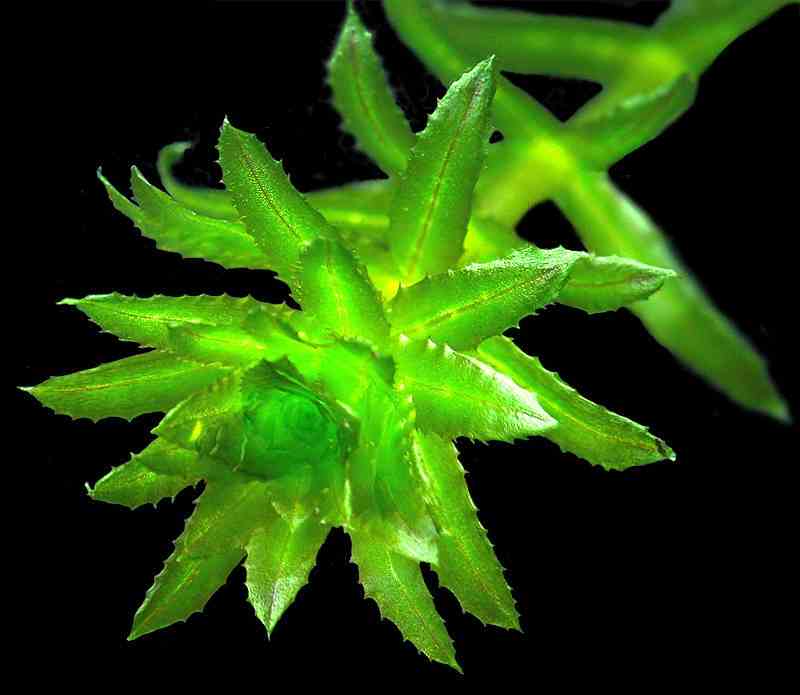
Hydrilla verticillata, photo by Indoaquascape
I am often asked can we eat Hydrilla? The answer is no, and yes.
There is only one species of Hydrilla, verticillata. The Hydrilla you buy in the health food store is the same that clogs lakes around the world. Can you take it out of a lake, cook it up, and chomp it down? No… Well, I don’t know of anyone doing that. But you can buy it as a dried powder to add to soups and stews and smoothies. So what’s the difference?
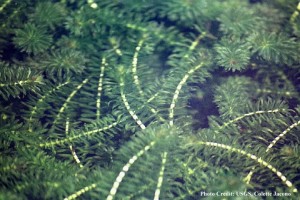
Hydrilla floating on the surface, photo by Colette Jacono
Hydrilla is an Eurasian weed that entered the western hemisphere via Florida sometime in the 1950’s probably through one aquarium dealer who imported live Hydrilla from Sri Lanka. It was subsequently found in a Miami canal, and from there it spread. In fact, for more than a decade no one knew it was Hydrilla. It was mistakenly called Elodea canadensis. However, within 10 years of its discovery Hydrilla became the most troublesome aquatic weed in the state. (It can expand 1,000 percent a year grow an inch a day.) Florida currently spends about $30 million annually trying to control it. The strain that was found in Florida was female. Twenty years later male Hydrilla was first reported in Delaware in 1976.
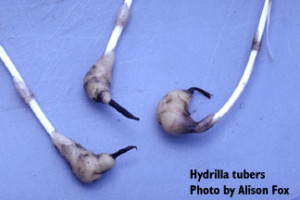
Hydrillas roots, photo by Alison Fox
Since that introduction some 60 years ago Hydrilla is now found in 19 states and Washington DC, from the endotrophic waters of Maine, west to wet Washington state. Called the perfect aquatic plant it adapts to a wide variety of climates and water conditions. Hydrilla can also reproduce four ways: rhizomes, tubers, turions (buds) and fragmentation. It, and Water Hyacinths, are the two most expensive weeds in the world. Because of the economic impact of the species there is a huge amount of information written about Hydrilla as a problem. Historical use of Hydrilla prior to it becoming a “noxious” weed is scant limited to a few references to how it was named and its use in making white sugar (more on that in a moment.)
A search of Chinese literature, for example, shows Hydrilla being cultivated for crab farming, and certain fish farming as well. They eat it. Duck like it, too, and snails. These are all foods the Chinese eat but no mentioning of eating Hydrilla directly. In the Philippines much is made of its nutritional qualities, but again no references found about eating it directly.
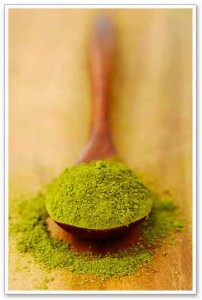
Hydrilla powder, photo by The Healers Store
As for powdered hydrilla… in north Florida they raise Hydrilla in an isolated lake, sterilize it with pure water and ozone treatment, low-temperature dry it, powder it and sell it to you. The mild earthy-flavored powder is 13% calcium which some writers call the richest plant source of calcium on the planet. It’s also high in B-12 and iron. Further, Hydrilla has been investigated as possible animal fodder. It has 16 percent more available dry matter for fodder than cattails and no bad chemicals were found in it during the examination for cattle food. In fact in one study when fed Hydrilla cows gave 20% more milk and chickens 14% more eggs, probably related to the calcium content. But what about Hydrilla as food for people?
As you know I developed and use the I.T.E.M approach to wild foods. Identification, Time of Year, Environment. M is for Method of Preparation. Here’s where the Hydrilla information trail breaks down. I’ve never found any reference in English about consumption of Hydrilla prior to the powdered form. In theory there should be no problem with eating Hydrilla (beyond the possible problems associated with any aquatic plant such as environmental pollution and some algae.) No special processing is done to make it an edible powder. The entire plant is dried and only water removed. So why isn’t Hydrilla used as human food like a cooked green? Well… edible does not mean palatable. As Dick Deuerling used to say about wild food: “I only eat the good stuff.”
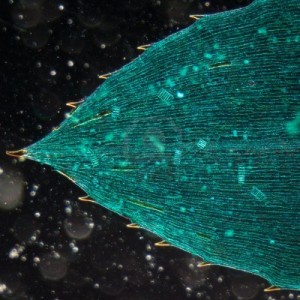
Hydrilla leaf, photo by 123rf
Here’s one possible reason: The plant is tough and prickly, not as bad as many land plants but noticeably so. In fact one quick and easy way to separate it from two similar looking plants (Elodea and Egeria) is to pull Hydrilla through your hand. Edodea and Egeria will feel smooth. Hydrilla will feel harsh and scratchy. It may simply be that texture kept the plant off the dinner table, that and the fact it can grow with just 1% of sunlight. That allows Hydrilla to inhabit cold dark deep areas of lakes one might not want to bother with if there are other edible plants around.
One tentative down side is when water condition are just right (or wrong depending on perspective) there can be a blue-green algae bloom which can grow on the top leaves of Hydrilla. That cyanobacteria can produce toxic chemicals. And while that is a warning about Hydrilla is should be looked out for on every aquatic plant that one might eat (and that includes seaweed as well.) Always avoid blue-green algae.
In English most pre-1960 references to Hydrilla refer to making sugar or naming it. In sugar making a mat of Hydrilla was placed over crystallized brown sugar. Over the next few days moisture from the Hydrilla would percolate through the sugar lightening its color towards white from brown. The whitened sugar would be scraped off and a new layer of Hydrilla added. As for naming the plant…
Hydrilla is fairly easy. It’s from the Greek ύδωρ (EE-dor) or “hydro” in English meaning water thus referring to its water habitat. Verticillata means whorls, as in the leaves. Linnaeus himself named it Serpicula verticillata. Over the centuries it has had many different names. Hottonia serrata, Hydrilla angustifolia, Hydrilla dentata, Hydrilla ovalifolia, Hydrilla wightii, Leptanthes verticillatus, Vallisneria verticillata, and Udora verticillata. One Claude Richard (probably Louis claude Marie Richard, 1754 – 1821) came up with the genus name Hydrilla. As it was a monotypic genus — only one species in it — Linnaeus’ species name verticillata stayed. Thus in time Hydrilla verticillata was dubbed. And while in English we say high-DRILL-ah its botanical pronunciation is: HID-ril-lah ver-ti-ki-LAH-tah.
No, I have not personally tried some. When I find some clean water I will. And special thanks to “Josey” for providing some historical data. To seen an older but good video by the state of Florida on Hydrilla click here.
Green Deane’s Itemized Plant Profile: Hydrilla
IDENTIFICATION: Hydrilla is a submersed plant that can form dense mats. Its stems stems are slender, branched and up to 25 feet long. The small leaves are strap-like and pointed. They grow in whorls of four to eight around the stem. The leaf margins are distinctly saw-toothed. Hydrilla often has one or more sharp teeth along the length of the leaf mid-rib. The midribs of the leaves are reddish in color. Hydrilla produces tiny white flowers on long stalks. It also produces 1/4 inch turions at the leaf axils and tubers attached to the roots in the mud. Tubers are yellowish, potato-like, 1/2 in. long, 1/2 inch broad. They can remain viable for four years. One tuber can produce more than 6,000 new tubers. There are two kinds of Hydrilla in North America, plants with just female blossom and those with male and female blossoms. The easiest way to tell them apart is female flowers consist of three whitish sepals and three translucent petals. Male flowers have three whitish to red petals and three red or brown sepals.
TIME OF YEAR: In North America southern populations overwinter as perennials; northern populations overwinter and regrow from tubers.
ENVIROMENT: Hydrilla can grow in almost any freshwater: springs, lakes, marshes, ditches, rivers, tidal zones with 7% salinity or less. It can grow in a few inches of water, or in water more than 20 feet deep. Hydrilla can grow in low nutrient to high nutrient conditions. It is somewhat winter-hardy though its optimum growth temperature is above 68 F. As mentioned it can grow in only 1% of full sunlight.
METHOD OF PREPARATION: Dried and powdered. Edibility of the tubers, if any, is totally unknown to me.

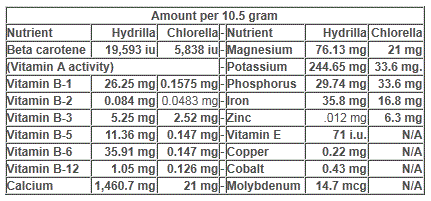
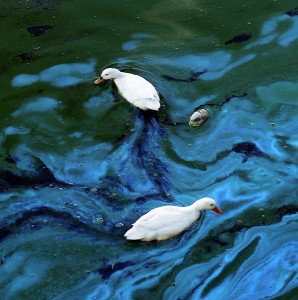


My neighbors and I obtained a permit to rake-harvest hydrilla from our canal, and have an agreement with the Aquatic Plant Management crew to NOT spray our canal with herbicide as long as we keep the growth managed with our rake-harvesting.
We regularly rake-harvest the hydrilla, chop it in a compost pit, or dry it on the seawall cap, and use it as an amendment in our garden. We see Hydrilla as a “locally available” FREE compost with NPK fairly comparable to conventional “cover crops” typically grown in Florida. Some research concludes that Hydrilla compost is fairly alkaline, so I add composted leaves, pine needles and other organics to the areas I amend with the Hydrilla. My soil tests in the neutral range. We’ve had the best Broccoli and Collard harvest EVER in the areas we amended with the Hydrilla + leaf mold compost. Tomato volunteers also seem to thrive in this home-grown soil amendment.
We’d love to see our State and Counties embrace a more sustainable method of Aquatic Plant Management and native ecosystem restoration, using mechanical harvesting rather than the toxic herbicides currently being used.
The harvested invasive exotic aquatics, like Hydrilla, if NOT contaminated with toxic herbicides, would certainly be a welcome and sustainable (even profitable) soil amendment for Florida’s farmers and home gardeners.
Though I have contacted SWFWMD, DEP and even the Governor’s office regarding the potential cost savings, environmental and economic benefits of less toxic and more sustainable harvest and use of Florida’s abundant exotic aquatics (like Hydrilla), I have NEVER been met with enthusiastic cooperation on a state level, and simply get the brush-off. I guess the herbicide lobby is quite strong here in Florida, and our state legislature and local governments have little interest in pursuing least toxic and sustainable habitat restoration.
I want a timeline of hydrilla
Wiht apologies, I don’t know what you mean.
Can you email me some more information on this? I am interested in finding out where the place in north Florida might be. Do you know exactly?
Hope, I had day dreaming that Wakulla Springs might take up this approach to management, with a garden for the lodge or a compost operation on site….
can i produce hydrilla in drinking water tank and this water can use for drink
A word of caution -according to Wikipedia, Hydrilla is a “hyperaccumulator of Mercury, Cadmium, Chromium and Lead.” This means it’s very important to use only plants grown in very pure waters, and even then, to monitor them closely for these metallic contaminants -whether the plant (or its products) are used as feed for humans or animals, or even as fertilizer.
Thanks for posting. I would like a different citation in that Wikipedia is not allowed to be referenced on this site because it is so inaccurate and not a trustworthy source of foraging information. If Wikipedia said the sun rose today I would check to make sure.
I love this website it has helped me in school
Hydrilla is very easy to cultivate.
If you don’t have a pond,you can grow it in plastic swimming pools.
add some gambusia minnows in the water to complete the cycle and you will have all the hydrilla you will ever need for soil amendments and composting. I put mine around the base of my tomato plants to prevent weeds and to shield the soil from drying out.
I found a website that maybe got overlooked.
I site was not over looked per se. I wrote my article years earlier and it it lifts a line from my article saying it is the highest source of calcium on the planet. What bothers me about the article is while it has been used for supplemental calcium it does not quote or cite or produce anyone who eats it. It’s a “round up” article but does not quote any one eating it or any expert saying it is edible right out of the water. The difference between her article and mine is I acknowledge its calcium content and use as a supplement but I do not cover eating it per se because I could not find anyone who has ever actually eaten it. It’s on my list of things to do.
this helped me out thx
I live on a lake that gets choked out every summer by this stuff. The Army Corp of Engineers spray it but does not seem to have much effect. All that I can find are articles that carry on about the damage to natural environment it does, how much is spent fighting it, and revenue lost because fishing and water sports suffer. If harvested does anybody buy it? I have searched and cannot find a buyer.
I only knew about eating hydrilla through the Beyond Meat burgers. I was so proud that they were using a plant that’s invasive (when I saw that bit of info on this site). This should be proof of people eating it: https://store.veganessentials.com/beast-burgers-by-beyond-meat-p4426.aspx
Well…. there is hydrilla powder in the mix.
hey dean, I read about you googling hydrilla. just bought your videos. I live on rainbow river florida and have a permit to remove hydrilla. I have seen first hand the overuse of herbicide on our habitat. I’m against all use of chemicals in river and on land. I want to hear more, to stop the chemical lobby and expose their evil ways
I just had two ag inspectors leave my farm after shutting me down completely. They found hydrilla in 3 of my tub gardens. I don’t sell it but I do use it as habitat for tiny fish fry and it clears up green algae in goldfish ponds very fast. Seems like they gave me a permit to sell it a while back…anyway, my old ag inspector retired and now I have these two new young whippersnappers laying down the law on me. So ridiculous for them to force me to be hydrilla free when nearly every body of water in the state is loaded with it. So if I want to grind up some dried hydrilla now, (to grow my hair out or something), I’ll have to buy it from India? I asked these boys who’s deciding what I can and can’t grow and they couldn’t answer, sounds kinda fishy to me. They put me out of business over it. Dang regulators!
Can anyone share a good reliable website or company that is clean in their process for the powdered Hydrilla? Lotus company seems to not sell any more. Im using another company that has capsules but is expensive ( 4 per day) I need this since I can not use any other type of calcium. Is there any company that will sell the raw plant and ship it to my home? I’d appreciate all the help
this website seems to not be safe… The Healers Store the hyper link opens and my computer tells me its not a safe website.
In advanced…thank you for your suggestions
Maureen I first procured hydrilla from Lotus also. Another option that you might have found by this time 5+ months later ~from the date of your comment~ is nutricargo.com
I wish you the best along with to all interested in this amazing plant. Also a good soure of Vitamin K2 ~Mk7 + Mk4~ types will help immensely with best absorption as well as benefits.
Additionally a good way of vitamin D 3 improvement is UVB K-Sperti Lamp
and / or a product called dvelop that provides Cholecafediol for improved absorption. This raised blood serum levels faster than Cholecaferol does.